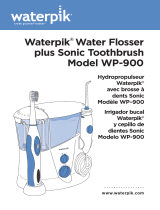For Countertop models:
1. Mix 2-4 tablespoons (1-2 ounces) of white vinegar with 16 ounces of warm water.
2. Fill the reservoir with the solution, and then run 1/2 of it through the Water Flosser.
3. With the unit off, place the Water Flosser handle in the sink and allow the solution to gradually
drain out of the handle.
4. Run any remaining solution through the unit and then rinse with a full reservoir of warm water.
For Cordless models:
1. Add 1 tablespoon of white vinegar to a full reservoir of warm water.
2. Point the handle and tip into the sink.
3. Turn unit ON and run until reservoir is empty.
4. Rinse by repeating with a full reservoir of clean warm water.
Charge the Unit (Rechargeable Cordless Models) or Replace
the Batteries (AA Battery Models)
To replace the batteries in the Cordless Express WF-02 or Cordless Freedom WF-03 Water
Flosser:
1. Replace batteries when there is a noticeable change in performance.
2. The type and quality of AA battery used impacts performance of the product.
3. Use 3 AA Batteries (Alkaline Or NiMH Only)
4. Replace all batteries at the same time with new batteries of the same type and brand.
To charge the Cordless Advanced Water Flosser WP-560/562/563/565:
1. Charge the unit prior to first use by plugging the power cord into the wall and place the
magnetic charger on the front of the unit for approximately 4 hours.
2. The charge indicator on the handle flashes when charging and stays on continuously when the
unit is fully charged. A full charge lasts for approximately 1 week of typical use.
3. When there is approximately 30% charge left, the charge indicator light blinks 8 times quickly
after use to indicate that you should recharge the unit. A complete recharge takes 3-4 hours.
To charge the Cordless Water Flosser WP-360 Cordless Plus Water Flosser WP-450, Cordless
Professional Water Flosser WP-440:
1. Ensure the power switch is in the OFF position when charging.
2. If you use your Water Flosser once a day or less, charge it overnight, once a week. If you use it
twice a day or more, charge the unit more frequently.
3. Do not run the battery down completely. This may shorten the battery lifespan and requires
charging the unit for 24 hours to obtain a full charge.










